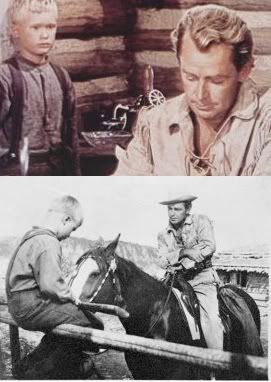 Randi Rhodes was riffing today about right wingers and their sick need for father figures.
Randi Rhodes was riffing today about right wingers and their sick need for father figures.The demoprotestant.blog refers to the phenomena: "Why are people giving up their rights? Why are Americans letting their government decide what they can put in their bodies, what they can do in the privacy of their homes, and whether or not they can have abortions? In my opinion this is because they need the government to act as a father figure. Because of the lack of connection with the land, what i mean is that all Americans are originally immigrants, there is a need for feelings of community. Even within homes, families are often divided by divorce. People move around the continent in search for jobs, and wherever they find themselves they start anew." Sort of what makes a guy think about one's attraction to Shane. An Amazon reviewer wrote:"I watched the movie Shane for the first time this past Friday. For a movie released in 1953, it's somewhat perverse. The American Film Institute recently judged Shane to be the 53rd most inspirational movie made in America. My reading of the film is undoubtably unorthodox, because I can't figure out quite what is inspiring about it.The movie is a fine example of Westerns made during this period. The conflict between good and evil is clearly delineated. In fact, the symbols of each category are pretty common for the Western:

There are three characters who stand outside of this dichotomy. One is Joey, the little boy. He is pre-sexual, and as such has soft "feminine" features, yet thrills to the romance of violence - although its reality frightens him. The boy combines features of both worlds, in the guise of Innocence. The other two characters who are either outside this dichotomy, or straddle it, are the gunfighters - Shane and Jack. They combine features of both worlds, in the guise of Experience. There's no question the gunfighter is masculine, for his resolves disputes with his (phallic) gun. On the other hand, he is very concerned with his appearance. He wears a fancy or elaborate costume; he has a pearl-handled pistol. His movements are deliberate, almost balletic. When Shane enters the picture, he is wearing buckskins. The movie takes place after the Civil War, and I wonder whether buckskins wouldn't be archaic. But this unique garb sets him apart from both the ranchers and the cattlemen. If the buckskins are indeed anachronistic, they mark Shane as one outside time."
All of this is a labored introduction to the fact that I digitized a portion of Jack Schaefer's novel of Shane as a slide show to be found here A portion of another review: "There are several themes arcing their way through this book. One deals with fate and how it is impossible to escape your past. Another involves violence; not reckless violence of the type employed by Fletcher and his goons, but a measured violence used to solve a seemingly insolvable situation. Schaefer shows us that no matter what our intentions in this life, there are going to be times when violence in the name of a cause is the only answer to those who are incapable of relying on any method other than intimidation to get what they want out of life. This is an excellent read for any type of reader both young and old, although that does not make it a necessarily easy book. The bare bones writing style makes it very easy to gloss over important themes and symbolisms. In other words, "Shane" is a book to think about both when reading it and after finishing the story. Reading the story more than once may not be a bad idea, as more themes are sure to emerge from this fascinating character study. Schaefer dedicated "Shane," his first book, to his first son. What a beautiful and wondrous tribute."






No comments:
Post a Comment